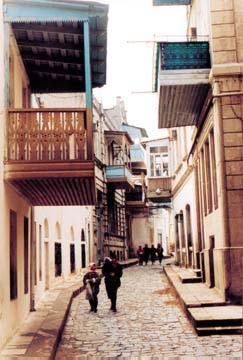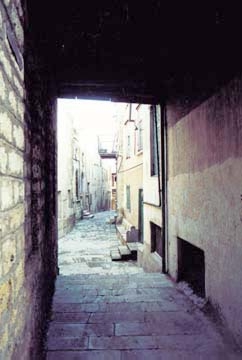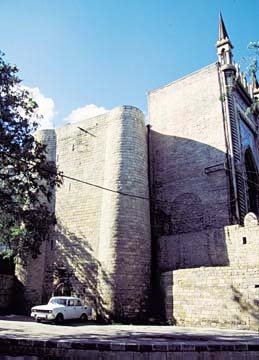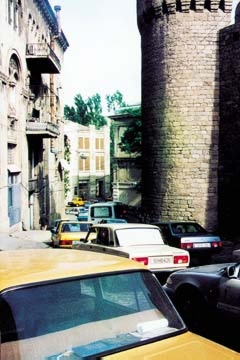|

Summer 2000 (8.2)
Pages
22-25
Ichari Shahar
- The Heart of Baku
A Living
Monument from the Middle Ages
by
Mir Teymur
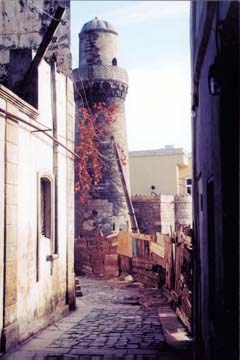  Ichari
Shahar (pronounced i-char-I sha-HAR) literally means "inner
city", the area of Baku defined by the citadel wall that
surrounds most of it. Foreigners refer to it as the "Old
City", since it's the oldest section of Baku. Ichari
Shahar (pronounced i-char-I sha-HAR) literally means "inner
city", the area of Baku defined by the citadel wall that
surrounds most of it. Foreigners refer to it as the "Old
City", since it's the oldest section of Baku.
Many Azerbaijanis believe that the Inner City as well as the
Maiden's Tower inside it were built in the 12th century. According
to some researchers, however, construction may date back as early
as the 7th century. The question has not been completely settled.
Even though its streets are neutral - toned with browns, beige,
gray and an occasional white, artists invariably depict Ichari
Shahar with a vibrant rainbow of colors - as if attempting to
capture the excitement of its lively crooks and crannies.
Ichari Shahar's character has changed considerably since Azerbaijan's
independence. Commercial ventures have started to spring up,
and the medieval town has attracted a great deal of foreign investment.
Yet there are still relatively few tourist shops or restaurants
in its winding streets. Perhaps that's part of its charm - it's
still a private, friendly space that many Azerbaijanis call home.
Photo: Inner
City, Baku. Oleg Litvin
When we interviewed artist Mir Teymur (1947-), who has lived
in Ichari Shahar for the past 30 years, we asked him to reflect
on the changes he has seen in Baku's medieval Inner City. He
talks about the community's struggle to maintain its unique character
and sense of history, a struggle that sees more defeats than
victories. Yet Mir Teymur believes that the essence of Ichari
Shahar is still intact - as long as you look closely enough to
find it.
_____
Memories of the
Past
Every stone in Ichari Shahar bears witness to thousands of years
of history. One has to listen to it, to pay attention. Some people
sense its history; others just pass by without understanding
anything at all.
Photos: Typical views from
Ichari Shahar (Inner City) which is believed to have been established
in the 12th century or earlier. The charm of the heart of Baku
has yet to be discovered by many tourists. Photos: Litvin and
Khanlou.
I have so many
fond memories of growing up in Ichari Shahar. I loved its narrow
streets and old houses with their overhanging balconies. One
of my favorite things was playing soccer with friends. Of course,
it was impossible to play ball in those narrow streets, so we
kids would gather in a nearby square. Another favorite game was
playing tag. We played it on the roofs of houses. We would chase
each other across the flat roof tops and laugh when the owners
would come out and shout at us.
During the Soviet period, we celebrated Novruz (the traditional
Spring Festival in the region - March 21) in secret because it
was prohibited by the government as it was associated with nationalism.
One popular Novruz tradition is for kids - especially the boys
- to build bonfires and jump over them. We could only build bonfires
in the narrow streets - not the major ones, for fear of being
caught. Today, children in Ichari Shahar still jump over bonfires
at Novruz. Today, they can do it openly.
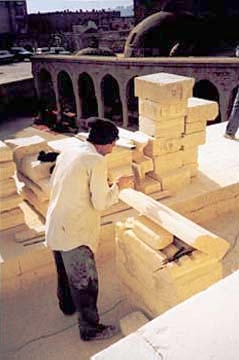 |
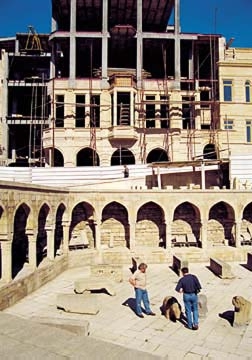 |
Photos above:
Considerable
reconstruction is going on these days. Some of it blends in well
with the architecture of the Inner City which has evolved over
the centuries. Some of it doesn't which, naturally, causes some
residents deep concern. Photos: Blair
Another wonderful thing about Novruz was the smell of sweets
like "pakhlava" (baklava), "shakarbura" and
"goghal". People would give these treats to their neighbors
and relatives. I remember how my grandmother would set aside
time each year especially to prepare Novruz treats.
We had another tradition of giving food - especially kebab -
to our neighbors. It wasn't that our neighbors were poor, or
anything like that. It was just a matter of friendship. This
tradition is dying away, however.
Above left:
The Sinig
Gala known by the local residents as "Broken Tower"
because it was destroyed in the 18th century when Russia's Peter
I attacked the city. Photo: Blair
Other photos: Typical views from Ichari Shahar (Inner
City) which is believed to have been established in the 12th
century or earlier. The charm of the heart of Baku has yet to
be discovered by many tourists. Photo: Pirouz Khanlou
One of the sounds I associate with Ichari Shahar is the mugham
music that seemed to float out of every open window in the summertime.
Unfortunately, these days I don't hear this lovely national music
coming out of windows; instead, there seems to be all sorts of
foreign music - very little Azerbaijani.
Another sound I remember was that of people playing "nard"
(backgammon) - the sound of dice rolling across the board and
the sliding and clicking of the round playing pieces. When it
was warm outside, men would gather to play a game or two. These
days, people don't play backgammon that much but I still enjoy
inviting friends over and playing it at home.
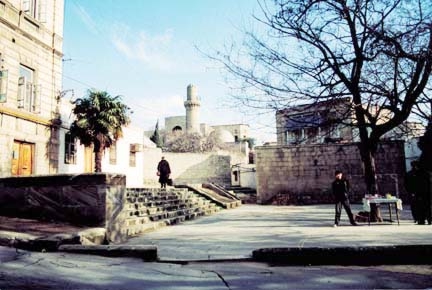
Old City.
Shirvan Shah's Palace in background, Baku. Photo: Pirouz Khanlou
In the past, I used to see so many familiar faces on these streets.
Nearly everyone I passed, I knew. Now most of the natives of
Ichari Shahar have moved to other places. It's rare to see as
many familiar faces any more.
On the street we used to say "Hello" to each other
even if we didn't really know each other. That was the tradition.
Sadly, too, this tradition is disappearing, too. There's another
distinction to Ichari Shahar - the moral and spiritual unity
of the community. If a person died and the relatives were mourning,
I used to stop in to pay my respects even if I didn't know the
family. Somehow, people felt connected to each other and sensed
a duty to reach out to one another. I wasn't the only one - all
of the people here felt united in the same way. We felt united
to each other and to these familiar alleys and buildings.
There used to be a very old mulberry tree that defined the square
which came to bear its name - Tut Aghaji Meydani (Mulberry Tree
Square). That tree would spread its shade and stain the pavement
with its fruit every summer. Then a few years ago, a big wind
came along and uprooted it. The man who lived next door cleared
the trunk and branches away and decided to plant a young mulberry
tree in the exact same spot as the old tree. He didn't want the
square to stop living up to its name - it was important to him
to maintain that history. Situations like that offer reassurance
that the spirit of Ichari Shahar lives on, despite all of the
changes.
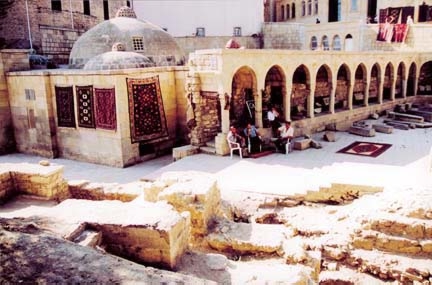
Old Marketplace
in the Old City, Baku: Photo: Blair
Walking Tour
Ichari Shahar, though very small and compact, has many kilometers
of winding lanes and alleys, which can best be enjoyed on foot.
I like people to understand the various levels in the old city
first. There's really quite a significant slope from sea level
up to the its highest point up to the inner walls of the Academy
of Science Presideum. I start at Gosha Gala Gapisi (Double Tower
Gate) and show them various streets until we reach the Shirvanshah
Palace. From there we go on to Yeddi Gumbaz (Seven Domes) of
the old bathhouse. Up the hill from Mulberry Tree Square is the
highest point in Ichari Shahar, guarded by Jebahan Tower, now
called Sinig Gala (Broken Tower). When Peter I ruled Russia in
the 18th century, military forces entered Baku and attacked the
city from two main points - Maiden's Tower on the waterfront
and Jebahan Tower at the highest peak. You can still see places
on Maiden's Tower where the artillery fired against it. Maiden's
Tower withstood the attack, but Jebahan Tower was destroyed.
To this day, it is known by the local residents as "Broken
Tower."
My favorite place of all in Ichari Shahar is the Maiden's Tower.
I often climb its winding staircase the eight floors to look
out over the city.
Ichari Shahar is divided into eight main districts, which are
said to have been established in the Middle Ages. One of them
is called "Seyids", which refers to the relatives of
the Prophet Mohammed. Hajis (those who had been on a pilgrimage
to Mecca) lived in this block as well. Another section is called
"Aghshalvarlilar" (literally "white-trousered
ones" which refers to those who have made the journey or
hajj to Mecca).
Another block is called "Bozbash yemayanlar" (those
who do not eat "bozbash"). Bozbash is an Azerbaijani
dish made of chopped meat, peas and potatoes mixed with spices.
Other blocks were for "Lodkachilar" (Boat men), "Hamamchilar"
(Bathhouse workers), "Arabachilar" (Wagoners), "Juhud
Zeynallilar" (Jewish Zeynallis) and "Noyutchular"
(Oil men). One last block is called "Shahgaldilar",
meaning "the shah came." Some of the names define occupations
of their early occupants; others, obviously, carry some humor
that is lost on us today.
Nevertheless, these names are still preserved in Ichari Shahar,
despite the fact that there are fewer and fewer natives actually
living here. Many people are moving away - not because they want
to, but because they can sell their property and live comfortably
elsewhere, for example, in Gunashli. Of course, they can't be
blamed. They don't have a lot of money, so they're forced to
sell their houses during these difficult economic times. Still,
there are some who won't move, no matter how much money you offer
them. They are deeply attached to their roots and would rather
die than move.
Defense Strategy
Ichari Shahar was not built using a straightforward design. For
instance, you wander down a narrow alley and suddenly hit a blind
alley. Why? It's not because that was the way houses were built
back then. It was planned that way.
Let's say that the Gosha Gala Gapisi (Double Tower Gate) is destroyed,
and invaders enter Ichari Shahar on horses. Four horses can run
abreast on a wide street, but if they hit a narrow alley, the
horses have to file behind each other one by one. It's a lot
easier to wipe out the enemy one by one.
What's the best way to stop invading forces? Build a city with
winding, confusing streets and unexpected dead ends. Also, it's
not easy to invade a city that can fight back on three or four
different heights. Ichari Shahar was designed so that its people
would be able to defend themselves from various heights above
the ground.
The layout of the streets in the Inner City offers other advantages
as well. Throughout the Middle East, including Azerbaijan, there
are dramatic temperature extremes throughout the year. In the
winter, it can be 20 degrees below zero [Celsius], while in summer,
it can reach 50 degrees above zero. Ichari Shahar's narrow streets
benefit from the considerable amount of shade cast from adjacent
buildings. Furthermore, the houses' walls are nearly one meter
thick which provides a natural cooling system.
Disturbing Changes
Ichari Shahar has changed a great deal in the past decade. Many
new buildings are springing up. A few years ago, there was a
mad rush by the international oil companies to refurbish old
buildings and set up their offices there. This created terrible
traffic jams, since these narrow streets were only built for
pedestrian traffic, or occasional horses or camels.
When these new buildings go up, you hear the sound of the excavator.
Our Constitution says that historical places must be protected,
and there is one section that prohibits the use of excavating
equipment. Even if you use a spade or shovel to dig, and you
come across a historical artifact or foundation, you are required
by law to consult with archeologists. They, in turn, judge if
you can continue your work or not.
Some of these new buildings have been built over underground
water reservoirs. In early times, people knew about it and dug
wells on each street so that they could have clean, cold water.
We have an expression in Azeri that warns that it's a sin to
cast anything into a well. The greatest sin is to cover a well
with stone or soil. It's like swearing at the native land.
The process of destroying wells in Ichari Shahar started late
in the 18th century and reached its peak in the 19th century,
when Russian factories and the British came here in 1840. The
British came here in order explore resources. Baku became a crossroads
- which had its good sides and its bad sides.
At that time, the Russians occupied the whole wall from Gosha
Gala (Double Tower, where the double gates are located) and made
a stable alongside it. After they left, the Soviet government
established itself (1920). The Soviet built a shoe factory inside
Ichari Shahar. What was that all about? We couldn't breath fresh
air. We coughed and choked.
Of the new buildings being constructed today, most do not fit
the pattern of architecture peculiar to this part of Baku. Actually,
this process started long ago, not just when we gained our independence
in 1991. The trend started as early as the 1970s.
It used to be that people were afraid of destroying the buildings
here. During the Soviet period, top officials were afraid they
would lose their jobs if they gave someone permission to demolish
a building. It was easy to bring accusations against someone
for such an offense in the newspapers. So out of fear, Ichari
Shahar retained much of its medieval character. Of course, it
would be better if people at that time had acted out of conscience
rather than fear. These days, people don't act out of either
- fear or conscience. Any building can be sold.
In some cases, people are building new houses instead of restoring
the historic ones. This totally changes the appearance of Ichari
Shahar. I don't have anything against people moving here. But
I would like them to care about Ichari Shahar and not destroy
its history.
The house I live in is more than 100 years old. It's a very warm
place. I don't mean "warm" in the physical sense, but
in the way that it gives the people who visit a comfortable,
friendly feeling. People who stop by this house for just 10 minutes
find that they don't want to leave it for a long time. This is
the secret of my house. It's the secret of Ichari Shahar, too.
You come and you want to stay for a long time.
Mir Teymur studied at Azerbaijan
State Arts School and the Leningrad Arts-Industrial College.
In 1972, he joined the art faculty at the Leningrad Institute
of Theater, Music and Cinema. Mir Teymur was interviewed by Mazahir
Panahov and Farida Sadikhova.
From Azerbaijan
International
(8.2) Summer 2000.
© Azerbaijan International 2000. All rights reserved.
Back to Index
AI 8.2 (Summer 2000)
AI Home
| Magazine Choice | Topics
| Store
| Contact
us
|



